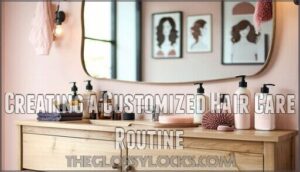This site is supported by our readers. We may earn a commission, at no cost to you, if you purchase through links.
 Most women think they know what "healthy hair" looks like—until they realize their best friend’s definition involves waist-length goddess waves while theirs stops at "frizz-free and cooperating." The truth is, hair goals aren’t one-size-fits-all, and chasing someone else’s vision can leave you frustrated with products that don’t work and routines that feel like chores.
Most women think they know what "healthy hair" looks like—until they realize their best friend’s definition involves waist-length goddess waves while theirs stops at "frizz-free and cooperating." The truth is, hair goals aren’t one-size-fits-all, and chasing someone else’s vision can leave you frustrated with products that don’t work and routines that feel like chores.
Before you can transform your hair, you need to figure out what you actually want from it—not what Instagram says you should want. Whether you’re after length, moisture, volume, or just hair that doesn’t fight you every morning, learning how to determine your hair goals gives you a roadmap that matches your natural texture and fits your real life.
Once you nail down what matters most to you, everything from product picks to styling habits finally starts making sense.
Table Of Contents
- Key Takeaways
- How to Identify Your Personal Hair Goals
- Assessing Your Hair Type and Needs
- Setting Realistic and Achievable Hair Goals
- Creating a Customized Hair Care Routine
- Tracking Progress and Staying Motivated
- Frequently Asked Questions (FAQs)
- What type of products should I use to add volume to my hair?
- Are there any natural ingredients that can help boost my hair?
- How often should I use volumizing hair care products?
- What are the benefits of using personalized hair care solutions?
- How often should I trim hair for growth?
- Can diet changes improve hair quality quickly?
- What role does water temperature play in washing?
- Should I switch products if goals change?
- How do hormones affect hair goal timelines?
- Conclusion
Key Takeaways
- Hair goals aren’t universal—defining what you actually want (length, moisture, volume, or strength) prevents you from wasting time on products and routines that contradict each other and don’t match your natural texture.
- Understanding your hair’s texture, porosity, thickness, and scalp health gives you the foundation to pick products and treatments that actually work instead of experimenting blindly.
- Targeted hair care based on clear goals makes your routine sharper and more effective—you’ll see real results like stronger roots and lasting shine without the guesswork.
- Tracking progress through monthly measurements, photos, and scalp checks keeps you motivated and helps you adjust your regimen before small issues become major setbacks.
How to Identify Your Personal Hair Goals
Before you can transform your hair, you need to know what you’re actually working toward. Most women want healthy hair, but that means different things depending on whether you’re chasing length, fighting frizz, or just trying to get your curls to cooperate.
Let’s break down the most common hair goals and why getting clear on yours is the first step to better hair days.
Common Hair Goals for Women
Most women chase one of five hair goals: length and growth, moisture and hydration, volume and body, strength and reduced breakage, or shine and natural beauty. Your hair goals might blend a few of these—maybe you want healthy length plus styling options that hold, or natural hair care that boosts hair health improvement without sacrificing texture.
Identifying what you’re really after shapes your entire hair care routine and keeps you from spinning your wheels on tips that don’t serve your vision. Understanding sustainable haircare trends can also help inform your hair goals and routine.
Why Defining Hair Goals Matters
Without a clear target, you’ll bounce between product recommendations and hair care tips that contradict each other—and your hair will show it. Defining your hair goals gives your hair journey direction and keeps you from chasing every beauty standard that doesn’t fit your personal style.
When you know whether you’re after hair growth, moisture, or strength, you’ll invest in hair care that actually builds self-confidence and nurtures natural hair health.
Benefits of Targeted Hair Care
Once you zero in on what your hair actually needs, everything from product choices to styling habits becomes sharper, faster, and way more effective. You’ll spend less time experimenting and more time seeing real results—stronger healthy roots, natural shine that actually lasts, and a hair regimen that nurtures scalp care and hair growth without the guesswork.
Targeted hair care turns your routine into a tool for hair health, not just another chore.
Assessing Your Hair Type and Needs
Before you can chart a path to your dream hair, you need to know where you’re starting from. Understanding your unique hair makeup isn’t just helpful—it’s essential for picking the right products and routines.
Let’s break down the three key factors that’ll shape your entire hair care strategy.
Determining Hair Texture and Porosity
Think of your hair texture and porosity as the foundation of your entire hair care strategy. Start with the Andre Walker system to identify if you’re working with straight, wavy, curly, or coily hair—each type has distinct follicle structures that influence moisture levels and cuticle health.
Test porosity by dropping a clean strand in water: if it floats, you’ve got low porosity; if it sinks, it’s high. Understanding these basics unlocks the right products for your natural hair type.
To achieve peak hair health, consider your hair’s moisture levels when selecting products.
Evaluating Hair Length, Thickness, and Strength
Your hair’s length, thickness, and strength tell a story about what it needs—and where you can push it further. Measure thickness by feeling a single strand between your fingers—thin hair snaps easily, while thick strands feel sturdy.
Test hair strength by gently stretching a wet strand: if it breaks immediately, you’re dealing with breakage that needs protein treatments and length retention strategies. Healthy follicle health means your hair grows without constant snapping at the ends.
Understanding Scalp Health and Oil Levels
A healthy scalp is the foundation for achieving any hair goal—when oil levels go haywire, follicles struggle and strands suffer. Check your scalp health and oil balance with these steps:
- Observe sebum production by noting if roots feel greasy within 24 hours (excess oil can clog follicles and weaken hair)
- Look for scalp irritation like itching, flaking, or odor—signs of oil imbalance or conditions needing scalp care and treatment
- Assess your hair follicle care routine to guarantee proper oil balance management facilitates hair health and wellness through targeted hair maintenance
Setting Realistic and Achievable Hair Goals
Now that you’ve got a clear picture of your hair type and what it needs, it’s time to zero in on what you actually want to achieve. Your goals should match your hair’s natural vibe and fit into your real life—not some fantasy routine you’ll never stick to.
Let’s break down the three main areas where you can set goals that actually work.
Moisture, Body, and Strength Objectives
Every head of hair has its own language—some whisper for moisture, others shout for volume, and a few are quietly begging for strength. Your job is to listen and decode what yours needs most. Focus on one core objective—Moisture Balance, Hair Fortification, or volumizing body—to create a game plan that actually works.
| Objective | What Your Hair Needs |
|---|---|
| Moisture Balance | Deep conditioning weekly; Hydrate with leave-ins; Scalp Nourishment with natural oils |
| Body & Volume | Lightweight products; root-lifting techniques; avoid heavy conditioners on roots |
| Strength & Fortification | Protein Repair treatments; minimize heat; finger detangling to reduce breakage |
| Combination Goals | Rotate treatments; Moisturize ends, Strengthen mid-lengths |
| Hair Health Benefits | Consistency unlocks growth, shine, and resilience over time |
Style and Texture Preferences
Some people want their hair to fall in soft waves, others crave sleek glass-like shine, and a few are all about that wild, voluminous texture that turns heads. Your style preference should match your natural hair type—fighting your texture is a losing battle.
Whether you’re chasing curl definition, hair volume, or a smooth finish, pick texture enhancement methods that celebrate what you’ve already got, not what works against it.
Adjusting Goals for Hair Type and Lifestyle
Balancing hair goals with reality comes down to hair texture analysis and honest lifestyle adaptations. If you’ve got thick, coarse strands, frizz control might be 41% more likely to top your list than for fine-haired folks. High porosity hair demands 35% more deep conditioning, while oily scalps benefit from twice-weekly clarifying—scalp health management adjusts to your specific hair type.
Busy schedules require low-maintenance product customization and efficient hair regimen planning. Natural hair care tips work best when your hair goals and objectives align with how you actually live.
Creating a Customized Hair Care Routine
Once you’ve nailed down your hair goals, it’s time to build a routine that actually works for you. The right products, consistent habits, and targeted treatments make all the difference in reaching those goals.
Here’s how to put together a plan that fits your hair and your life.
Selecting Products for Your Hair Goals
Once you know what you want your hair to do, picking the right products becomes less guesswork and more strategy. Look at product ingredients that match your hair type—sulfate-free shampoos for moisture balance, natural oils for hydration, hair masks for deep repair.
Your hair goals drive your hair care product selection. So, if you’re chasing volume, skip heavy creams. If you need strength, reach for protein treatments. Match the product to the mission.
Daily and Weekly Maintenance Habits
Products matter, but what you do with them day to day is where real change happens. Build a hair regimen that works—shampoo two to three times a week, not daily. Rotate products to keep your scalp responsive.
Add scalp massage when you moisturize to boost circulation. Protective styles reduce manipulation.
Consistency in your hair maintenance routine beats flawlessness every time.
Incorporating Deep Conditioning and Treatments
Your daily routine is the foundation—now layer in deep conditioning every week to lock in real transformation. Pick a hydrating hair mask or protein treatment based on what your hair’s craving—moisture therapy for dry ends, hair repair for breakage.
Don’t skip it. This one step fuels real hair growth strategies and keeps your hair care routine from flattering to forget.
Tracking Progress and Staying Motivated
You’ve set your goals and built your routine—now it’s time to track what’s working. Seeing real progress keeps you fired up and helps you adjust when something isn’t clicking.
Here’s how to monitor your hair journey, push through rough patches, and own every small victory along the way.
Monitoring Hair Health and Growth
Consistency is your secret weapon regarding hair health maintenance and growth tracking. You can’t transform your hair overnight, but regular monitoring helps you spot what’s working—and what’s not—so you can adjust your hair regimen before minor issues turn into major setbacks.
- Measure monthly: Track hair length retention from the same scalp spot each time to catch real growth patterns
- Document with photos: Consistent lighting reveals changes in hair density and texture you might miss day-to-day
- Check your scalp: Regular scalp analysis detects early shifts in hydration, sebum, or microbiome balance
- Note your stress: Hair cortisol levels reflect chronic stress, so journaling helps connect lifestyle factors to hair growth strategies
Overcoming Setbacks and Plateaus
Even when you track everything perfectly, your hair will eventually hit a wall—and that’s when most people either panic or give up entirely. But plateaus aren’t failures—they’re signals to switch up your Hair Regimen with smart Plateau Strategies that prevent Hair Breakage and kickstart Hair Growth again.
Hair plateaus aren’t failures—they’re signals to adjust your regimen with smarter strategies that reignite growth
| Issue | Regimen Tweaks | Growth Mindset Shift |
|---|---|---|
| Hair Damage | Protein treatments for Damage Repair | Progress isn’t always linear |
| Slow Growth | Scalp massage + circulation boost | Small changes compound over time |
| Hair Breakage | Gentler detangling methods | Breakage Prevention beats length chasing |
| Dryness | Switch deep conditioner formula | Hair Maintenance > quick fixes |
Celebrating Small Wins and Adjusting Goals
Every achievement—no matter how tiny—deserves its moment, because chasing excellence without pausing to honor progress is the fastest way to burn out and abandon your hair goals altogether.
Lock in those Small Victories with Progress Tracking, then use them as fuel for your Hair Journey:
- Snap monthly comparison photos to visualize real Growth
- Adjust your Hair Care Routine when old Goal Setting strategies stop working
- Reward yourself when you hit Natural Hair Goals Achievement markers
- Revisit Motivation Tips whenever your Hair Goals feel out of reach
- Apply Adjustment Strategies the moment something isn’t working
Frequently Asked Questions (FAQs)
What type of products should I use to add volume to my hair?
Look for volumizing shampoos and lightweight conditioners that won’t weigh your hair down.
Root lifters and texturizing sprays work wonders for adding body.
Choose thickening serums and hair styling products designed for your specific hair type.
Are there any natural ingredients that can help boost my hair?
Think of natural ingredients as secret weapons hiding in plain sight. Absolutely—natural oils like coconut and argan deliver deep hair moisture, while plant extracts and essential amino acids strengthen strands.
Hair vitamins from herbal remedies support natural hair treatment, making your hair care routine truly revolutionary.
How often should I use volumizing hair care products?
If you’ve got fine natural hair, reach for volumizing products two to three times weekly—enough to add body without overwhelming your strands with product buildup.
Listen to your scalp’s sensitivity and adjust styling techniques as needed.
What are the benefits of using personalized hair care solutions?
Individualized hair care solutions deliver targeted treatments based on your unique hair type, matching bespoke products to specific hair goals.
This specialized approach creates healthy hair habits through hair analysis, ensuring tailored routines address exactly what your hair needs.
How often should I trim hair for growth?
Want hair that actually grows? Trim every 8-12 weeks to prevent split ends from traveling up your hair shaft.
Regular trimming isn’t about cutting off length—it’s about maintaining healthy hair that can grow freely without breakage sabotaging your progress.
Can diet changes improve hair quality quickly?
Diet changes support hair health over time, but quick results are rare. Nutrient intake, vitamin balance, and gut health nourish roots gradually.
Hair supplements can help, though addressing food allergies matters too. Hair growth takes patience—true hair nourishment unfolds with sustained hair care.
What role does water temperature play in washing?
Water temperature is like a tuning fork for your hair—strike the wrong note, and everything feels off. Hot water opens your hair cuticles, stripping natural oils and weakening hair elasticity, especially problematic for high hair porosity.
Cold rinses seal cuticles, boost shine, and soothe scalp sensitivity while locking in moisture from your shampoo technique and hair care routine.
Should I switch products if goals change?
Absolutely. When your hair goals shift—say, from moisture to body or strength—your product rotation should follow.
Your hair regimen works best when products align with current needs. Switching products based on goal adjustment isn’t just smart; it’s essential for effective change management in your hair care routine.
How do hormones affect hair goal timelines?
Hormone Balance shifts during pregnancy, menopause, or thyroid issues can slow Hair Growth cycles, delay Hair Goals, and temporarily alter Hair Type.
Understanding these natural Hair Cycles helps you adjust your Hair Care timeline and maintain Hair Health through hormonal transitions.
Conclusion
Hair care without direction is like driving with no destination—you burn energy but never arrive. Once you know how to determine your hair goals, you stop wasting time on trends that don’t fit and start building routines that actually work for your texture, lifestyle, and vision.
Your hair won’t transform overnight, but clarity beats confusion every time. Now you’ve got the map—so take the wheel and make it happen.
- https://www.finenaturalhairandfaith.com/black-hair-medium-length-growth-styles/
- http://my.curlyhairlounge.com/hairjournal
- https://www.pinterest.com/curlyhairlounge/
- http://eepurl.com/bNAuy9
- https://www.functionofbeauty.com/ingredients/?utm_source=blog&utm_medium=We%20keep%20talking%20about%20hair%20goals








